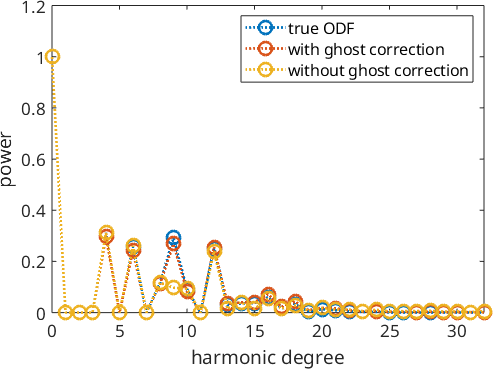This page demonstrates different sources of ambiguity when reconstructing an ODF from pole figure diffraction data.
The ambiguity due to too few pole figures
Due to experimental limitations, one is usually restricted to a short list of crystal directions (Miller indices) for which diffraction pole figures can be measured. In general, more measured pole figures implies more reliable ODF reconstruction and low-symmetry materials and weak textures usually requires more pole figures then sharp texture with a high crystal symmetry. From a theoretical point of view, the number of pole figures should be at a level with the square root of the number of pole points in each pole figure. This is of course far from experimentally possible.
Let's demonstrate the ambiguity due to too few pole figures at the example of two orthorhombic ODFs. The first ODF has three modes at the positions
cs = crystalSymmetry('mmm');
orix = orientation.byAxisAngle(xvector,90*degree,cs);
oriy = orientation.byAxisAngle(yvector,90*degree,cs);
oriz = orientation.byAxisAngle(zvector,90*degree,cs);
odf1 = unimodalODF([orix,oriy,oriz])odf1 = SO3FunRBF (mmm → y↑→x)
multimodal components
kernel: de la Vallee Poussin, halfwidth 10°
center: 3 orientations
Bunge Euler angles in degree
phi1 Phi phi2 weight
0 90 0 0.333333
90 90 270 0.333333
90 0 0 0.333333The second ODF has three modes as well but this times at rotations about the axis (1,1,1) with angles 0, 120, and 240 degrees.
ori = orientation.byAxisAngle(vector3d(1,1,1),[0,120,240]*degree,cs);
odf2 = unimodalODF(ori)odf2 = SO3FunRBF (mmm → y↑→x)
multimodal components
kernel: de la Vallee Poussin, halfwidth 10°
center: 3 orientations
Bunge Euler angles in degree
phi1 Phi phi2 weight
0 0 0 0.333333
90 90 0 0.333333
180 90 90 0.333333These two ODFs are completely disjoint. Let's check this by plotting them as sigma sections
figure(1)
plot(odf1,'sigma')
mtexColorMap LaboTeX
figure(2)
plot(odf2,'sigma')
mtexColorMap LaboTeX

However, when it comes to pole figures 7 of them, namely, (100), (010), (001), (110), (101), (011) and (111), are identical for both ODFs. Of course looking at any other pole figure makes clear that those two ODFs are different.
figure(1)
h = Miller({1,0,0},{0,1,0},{0,0,1},{1,1,0},{1,0,1},{0,1,1},{1,1,1},{1,2,0},cs);
plotPDF(odf1,h,'contourf')
mtexColorMap LaboTeX
figure(2)
plotPDF(odf2,h,'contourf')
mtexColorMap LaboTeX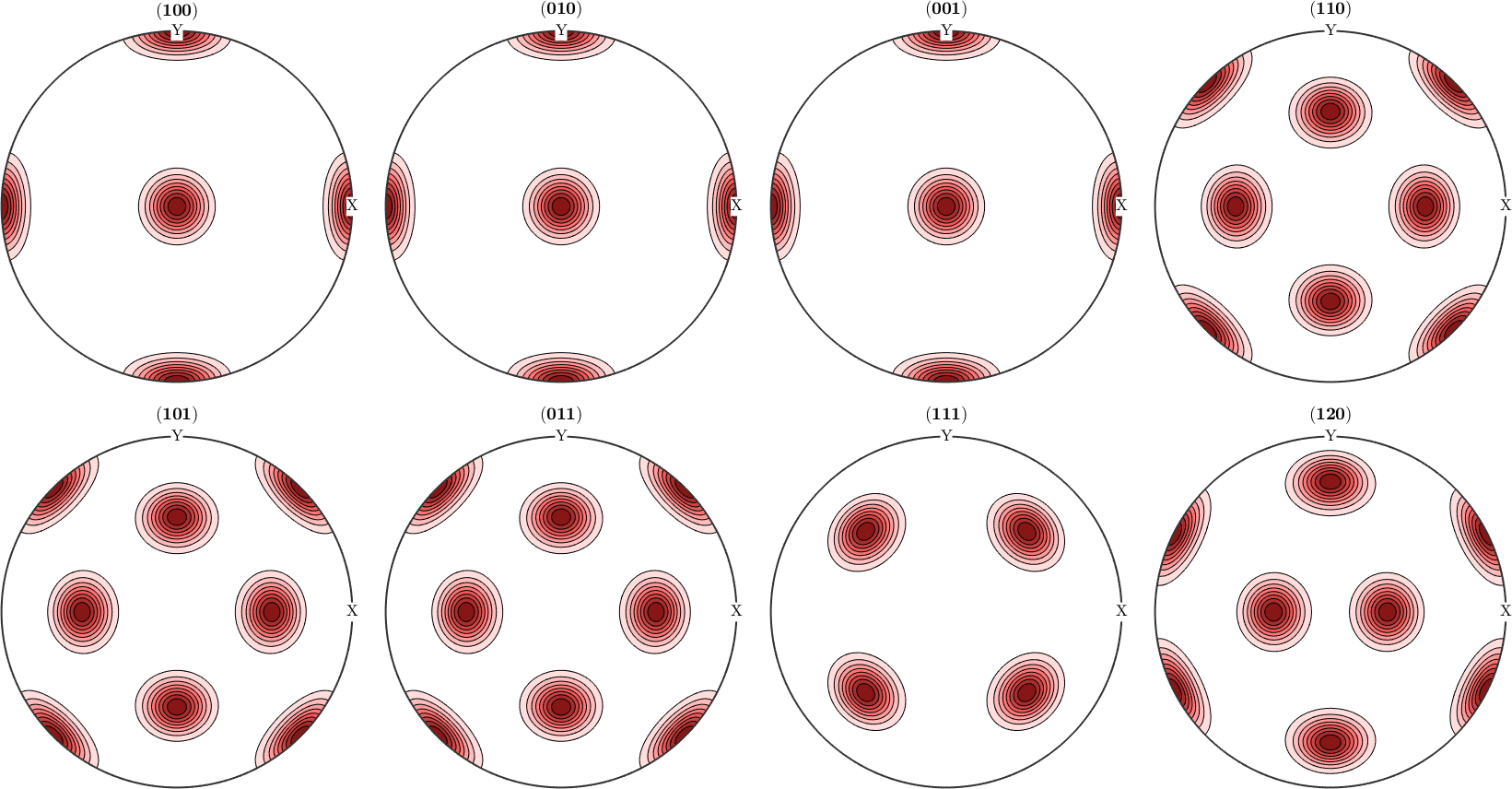

The question is now, how can any pole figure to ODF reconstruction algorithm decide which of the two ODFs was the true one if only the seven identical pole figures (100), (010), (001), (110), (101), (011), (111) have been measured? The answer is: this is impossible to decide. Next question is: which result will I get from the MTEX reconstruction algorithm? Let's check this
% 1. step: simulate pole figure data
pf = calcPoleFigure(odf1,h(1:7),'upper');
plot(pf)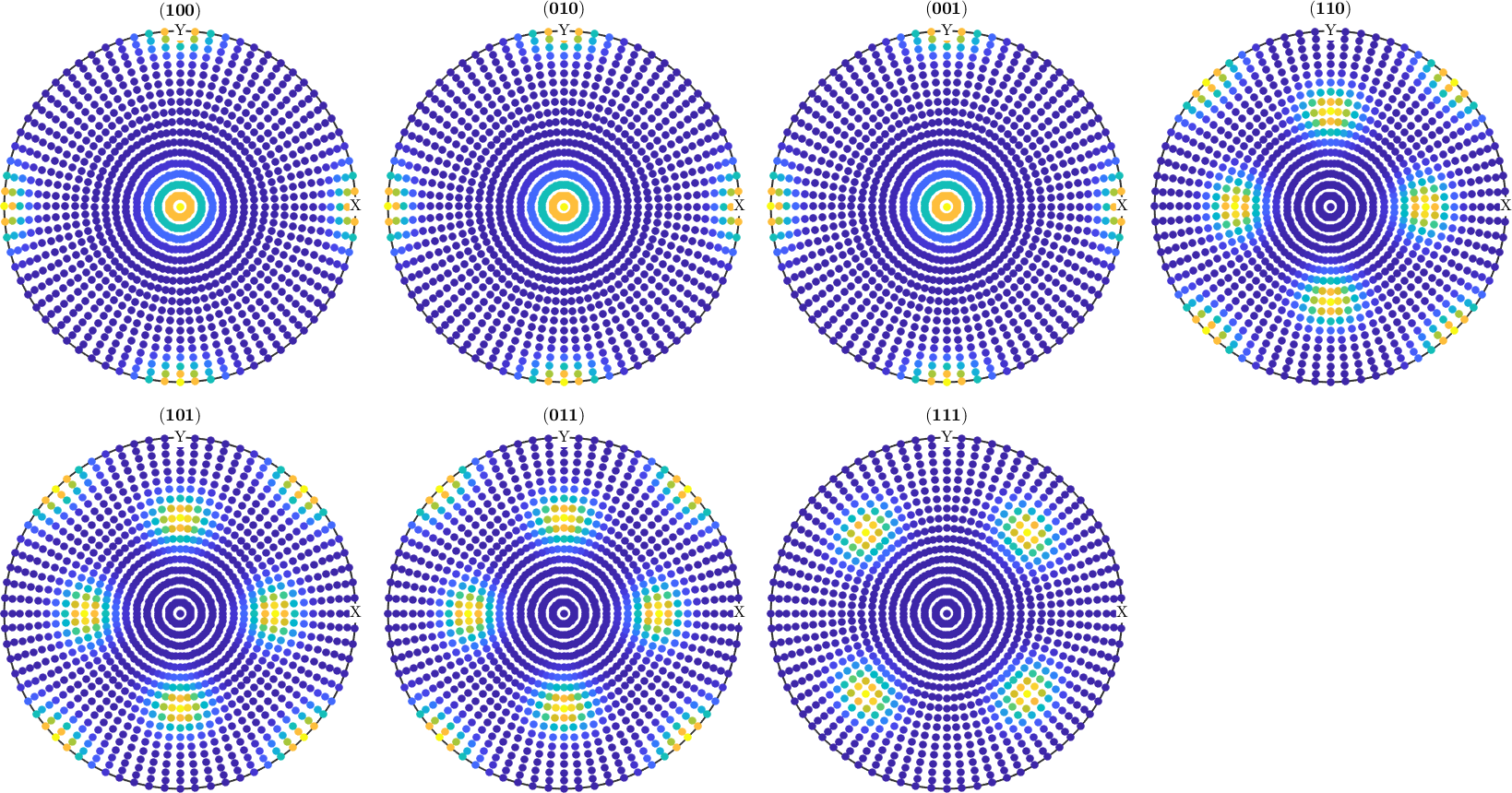
% 2. step: reconstruct an ODF
odf = calcODF(pf,'silent')
plot(odf,'sigma')odf = SO3FunRBF (mmm → y↑→x)
multimodal components
kernel: de la Vallee Poussin, halfwidth 5°
center: 29772 orientations, resolution: 5°
weight: 1
We observe that the reconstructed ODF is an almost perfect mixture of the first and the second ODF. Actually, any mixture of the two initial ODFs would have been a correct answer. However, the ODF reconstructed by the MTEX algorithm can be seen as the ODF which is closest to the uniform distribution among all admissible ODFs.
Finally, we increase the number of pole figures by five more crystal directions and perform our previous experiment once again.
% 1. step: simulate pole figure data for all crystal directions
h = [h,Miller({0,1,2},{2,0,1},{2,1,0},{0,2,1},{1,0,2},cs)];
pf = calcPoleFigure(odf1,h,'upper');
% 2. step: reconstruct an ODF
odf = calcODF(pf,'silent')
plot(odf,'sigma')odf = SO3FunRBF (mmm → y↑→x)
multimodal components
kernel: de la Vallee Poussin, halfwidth 5°
center: 29772 orientations, resolution: 5°
weight: 1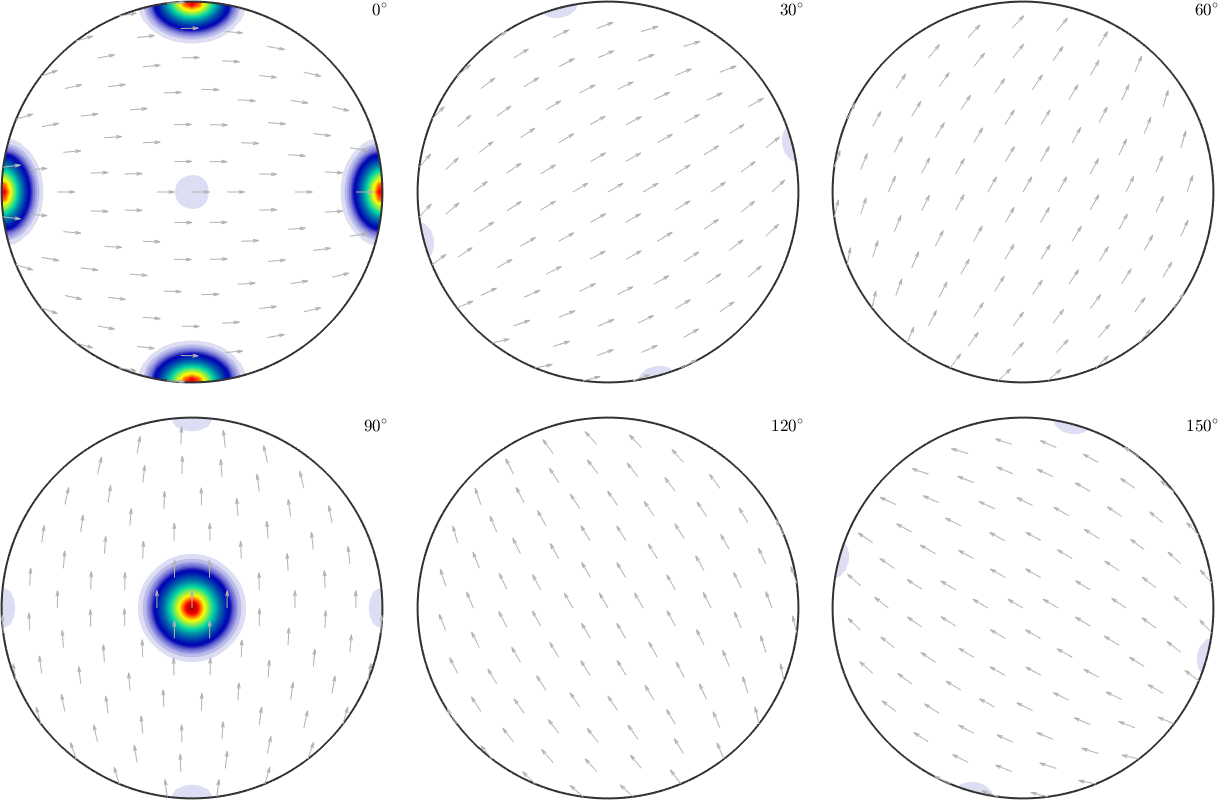
Though the components of odf2 are still present in the recalculated ODF they are far less pronounced compared to the components of odf1.
% 1. step: simulate pole figure data for all crystal directions
pf = calcPoleFigure(odf1,h,'upper');
% 2. step: reconstruct an ODF
odf = calcODF(pf,'silent')
plot(odf,'sigma')odf = SO3FunRBF (mmm → y↑→x)
multimodal components
kernel: de la Vallee Poussin, halfwidth 5°
center: 29772 orientations, resolution: 5°
weight: 1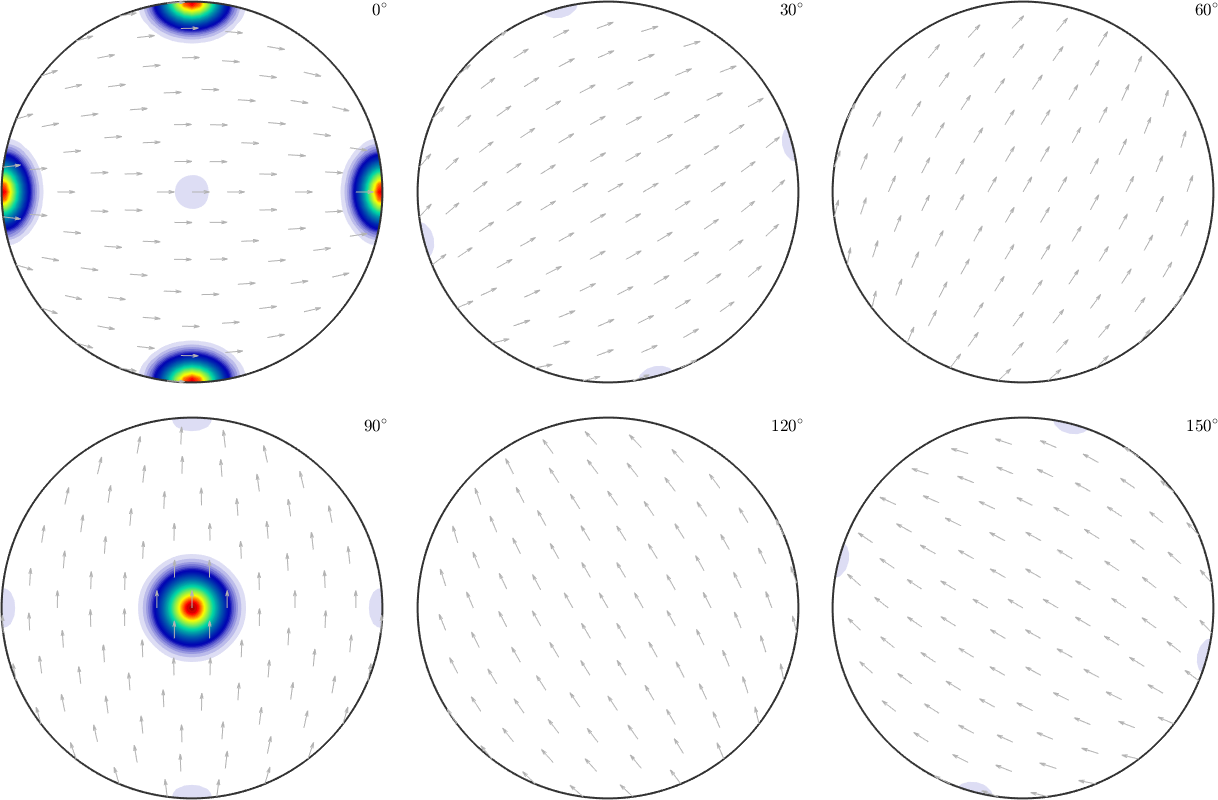
The ambiguity due to too Friedel's law
Due to Friedel's law pole figure data always impose antipodal symmetry. In order to demonstrate the consequences of this antipodal symmetry we consider crystal symmetry -43m
cs = crystalSymmetry('-43m')cs = crystalSymmetry
symmetry: -43m
elements: 24
a, b, c : 1, 1, 1and two rotations
ori1 = orientation.byEuler(30*degree,60*degree,10*degree,cs)
ori2 = orientation.byEuler(30*degree,60*degree,100*degree,cs)
h = Miller({1,0,0},{1,1,0},{1,1,1},{1,2,3},cs);
plotPDF(ori1,h,'MarkerSize',12)
hold on
plotPDF(ori2,'MarkerSize',8)
hold offori1 = orientation (-43m → y↑→x)
Bunge Euler angles in degree
phi1 Phi phi2
30 60 10
ori2 = orientation (-43m → y↑→x)
Bunge Euler angles in degree
phi1 Phi phi2
30 60 100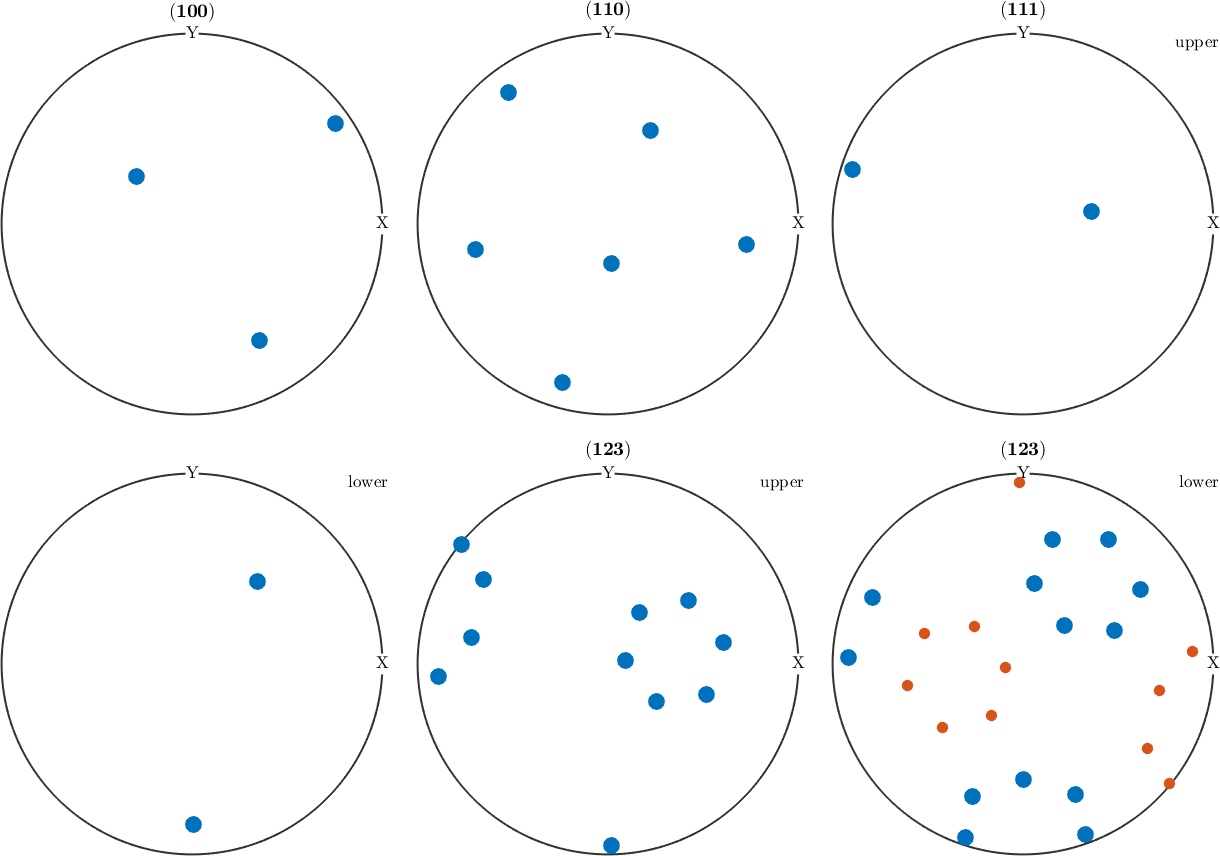
Obviously, both orientations are not symmetrically equivalent as -43m does not have a four fold axis. This can also be seen from the pole figure plots above which are different for, e.g., (111). However, when looking at an arbitrary pole figure with additionally imposed antipodal symmetry both orientations appears at exactly the same positions
plotPDF(ori1,h,'MarkerSize',12,'antipodal')
hold on
plotPDF(ori2,'MarkerSize',8)
hold off
The reason is that adding antipodal symmetry to all pole figures is equivalent to adding the inversion as an additional symmetry to the point group, i.e., to replace it by the Laue group. Which is illustrated in the following plot
ori1.CS= ori1.CS.Laue;
ori2.CS= ori2.CS.Laue;
h.CS = h.CS.Laue;
plotPDF(ori1,h,'MarkerSize',12)
hold on
plotPDF(ori2,'MarkerSize',8)
hold off
As a consequence of Friedels law, all noncentrosymmetric information about the texture is lost in the diffraction pole figures and we can only aim at recovering the centrosymmetric portion. In particular, any ODF that is reconstructed by MTEX from diffraction pole figures is centrosymmetric, i.e. its point group is a Laue group. If the point group of the crystal was already a Laue group then Fridel's law does not impose any additional ambiguity.
The inherent ambiguity of the pole figure - ODF relationship
Unfortunately, even for centrosymmetric crystal symmetry, knowing all pole figures of an ODF is not sufficient to recover the ODF unambiguously. To understand the reason for this ambiguity we consider triclinic symmetry and a week unimodal ODF with preferred orientation (0,0,0).
cs = crystalSymmetry('-1');
odf1 = 2/3 * uniformODF(cs) + 1/3 * unimodalODF(orientation.id(cs),'halfwidth',30*degree)
plotPDF(odf1,Miller({1,0,0},{0,1,0},{0,0,1},cs),'antipodal')odf1 = SO3FunRBF (-1 → y↑→x)
uniform component
weight: 0.67
unimodal component
kernel: de la Vallee Poussin, halfwidth 30°
center: 1 orientations
Bunge Euler angles in degree
phi1 Phi phi2 weight
0 0 0 0.333333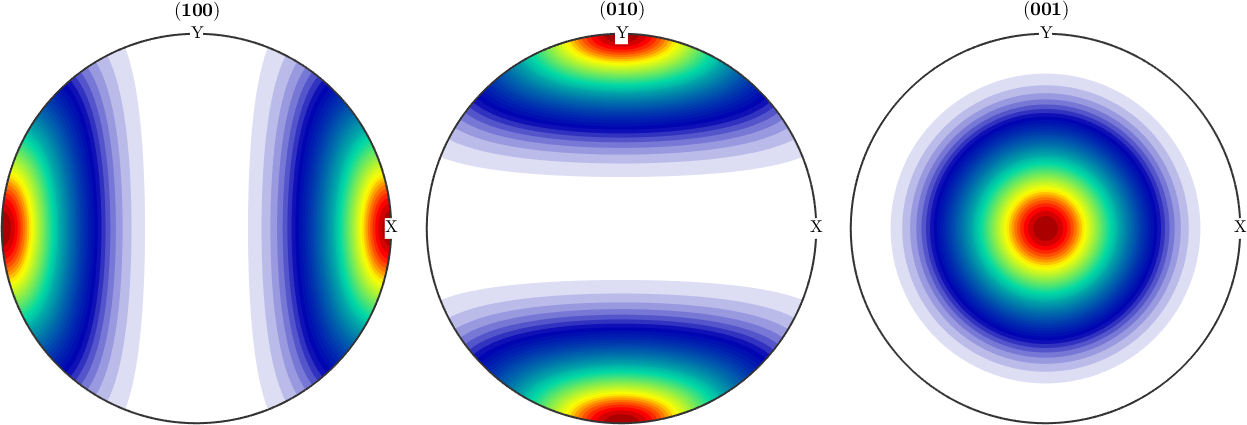
As any other ODF, we can represent it by its series expansion by harmonic functions. This does not change the ODF but only its representation
odf1 = FourierODF(odf1,10)
plotPDF(odf1,Miller({1,0,0},{0,1,0},{0,0,1},cs))odf1 = SO3FunHarmonic (-1 → y↑→x)
antipodal: true
bandwidth: 9
weight: 1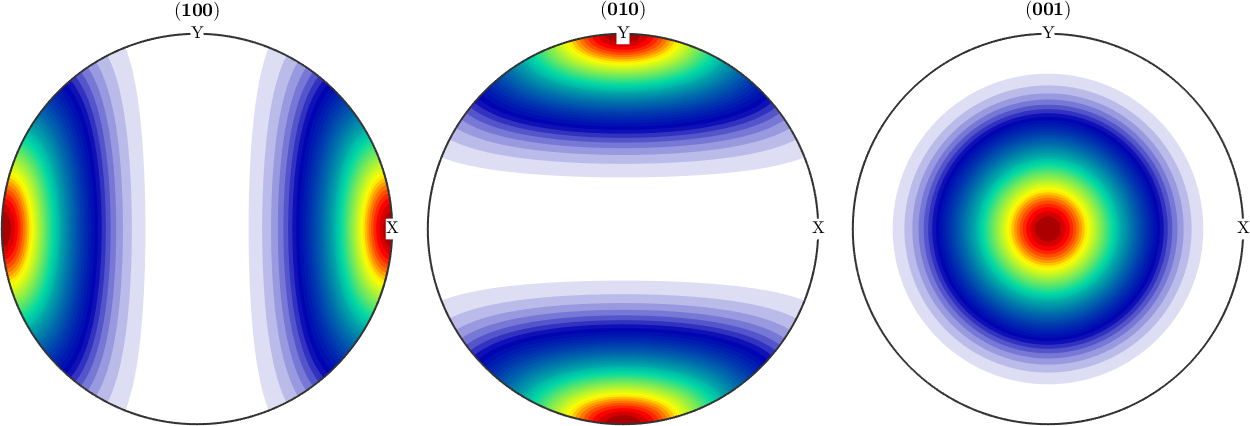
We may look at the coefficients of this expansion and observe how the decay to zero rapidly. This justifies to cut the harmonic expansion at harmonic degree 10.
close all
plotSpektra(odf1,'linewidth',2)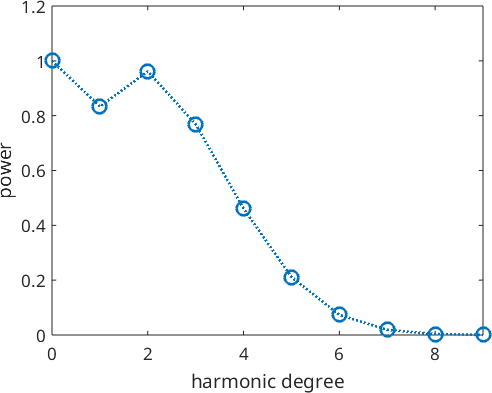
Next, we define a second ODF which differs by the first one only in the odd order harmonic coefficients. More precisely, we set all odd order harmonic coefficients to zero
A = mod(1:11,2)';
odf2 = conv(odf1,A)
hold on
plotSpektra(odf2,'linewidth',2)
hold off
legend('odf1','odf2')odf2 = SO3FunHarmonic (-1 → y↑→x)
antipodal: true
bandwidth: 9
weight: 1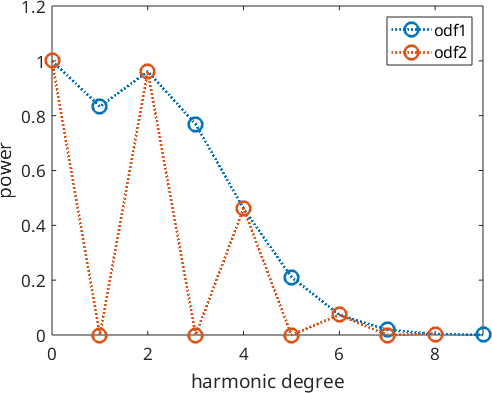
The point is that all pole figures of odf1 look exactly the same as the pole figures of odf2.
plotPDF(odf2,Miller({1,0,0},{0,1,0},{0,0,1},cs),'antipodal')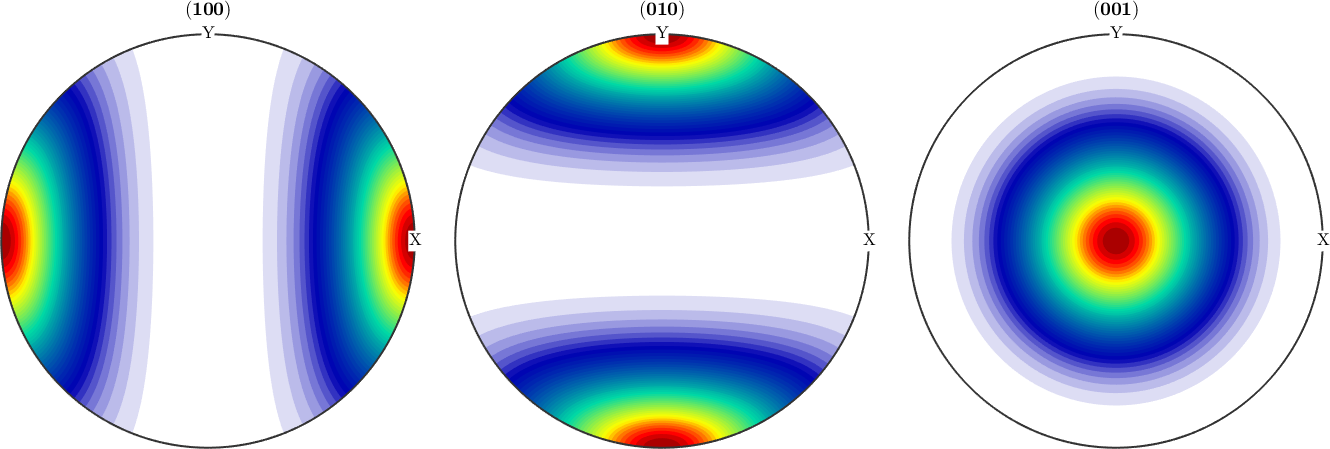
and hence, it is impossible for any reconstruction algorithm to decide whether odf1 or odf2 is the correct reconstruction. In order to compare odf1 and odf2, we visualize them along the alpha fiber
alphaFibre = orientation.byAxisAngle(zvector,(-180:180)*degree,cs);
close all
plot(-180:180,odf1.eval(alphaFibre),'linewidth',2)
hold on
plot(-180:180,odf2.eval(alphaFibre),'linewidth',2)
hold off
legend('odf1','odf2')
xlim([-180,180])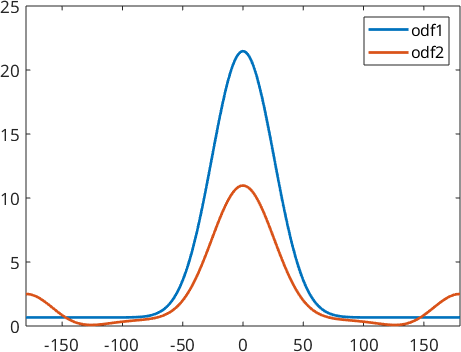
We can make the example more extreme by applying negative coefficients to the odd order harmonic coefficients.
odf1 = 4/5 * uniformODF(cs) + 1/5 * unimodalODF(orientation.id(cs),'halfwidth',30*degree);
A = (-1).^(0:10)';
odf2 = conv(odf1,A);
close all
plot(-180:180,odf1.eval(alphaFibre),'linewidth',2)
hold on
plot(-180:180,odf2.eval(alphaFibre),'linewidth',2)
hold off
legend('odf1','odf2')
xlim([-180,180])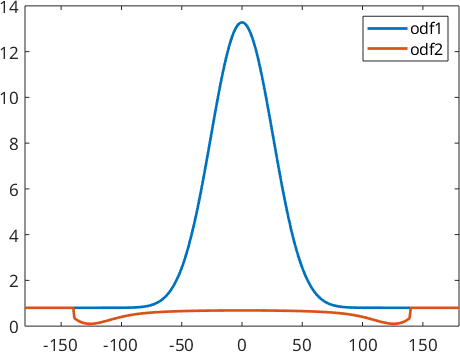
We obtain two completely different ODFs: odf1 has a preferred orientation at \((0,0,0)\) while odf2 has preferred orientations at all rotations about 180 degrees. These two ODFs have identical pole figures and hence, it is impossible by any reconstruction method to decide which of these two ODF was the correct one. It was the idea of Matthies to say that a physical meaningful ODF usually consists of a uniform portion and some components of preferred orientations. Thus in the reconstruction odf1 should be preferred over odf2. The idea to distinguish between odf1 and odf2 is that odf1 has a larger uniform portion and hence maximizing the uniform portion can be used as a method to single out a physical meaningful solution.
Let's demonstrate this by the given example and simulate some pole figures out of odf2.
h = Miller({1,0,0},{1,0,0},{0,1,0},{0,0,1},{1,1,0},{0,1,1},{1,0,1},{1,1,1},cs);
pf = calcPoleFigure(odf1,h);
plot(pf)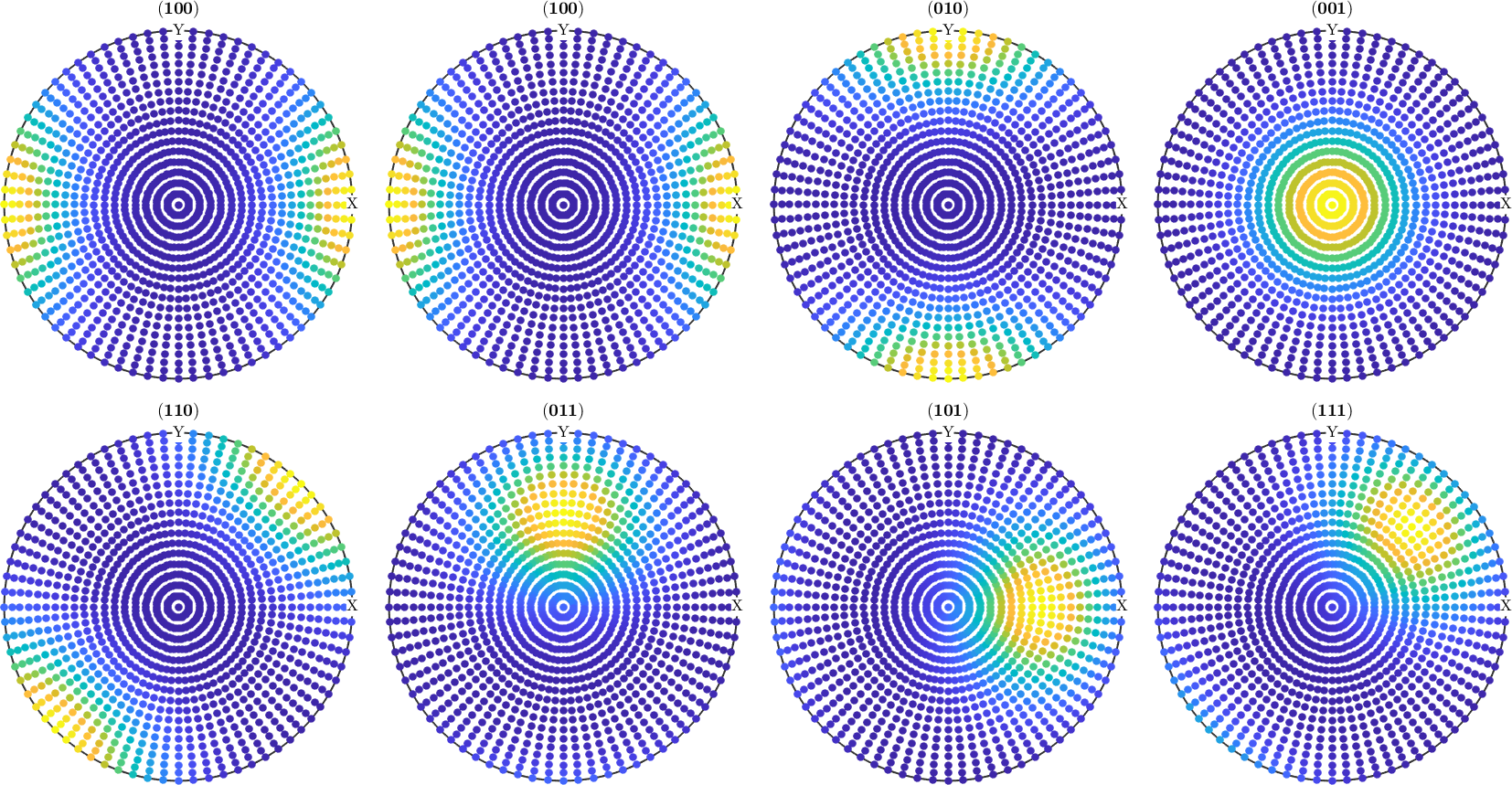
When reconstruction an ODF from pole figure data MTEX automatically uses Matthies methods of maximizing the uniform portion called automatic ghost correction
odf_rec1 = calcODF(pf,'silent')odf_rec1 = SO3FunRBF (-1 → y↑→x)
uniform component
weight: 0.8
multimodal components
kernel: de la Vallee Poussin, halfwidth 5°
center: 119088 orientations, resolution: 5°
weight: 0.2This method can be switched off by the following command
odf_rec2 = calcODF(pf,'noGhostCorrection','silent')odf_rec2 = SO3FunRBF (-1 → y↑→x)
multimodal components
kernel: de la Vallee Poussin, halfwidth 5°
center: 119088 orientations, resolution: 5°
weight: 1When comparing the reconstructed ODFs we observe that by using ghost correction we are able to recover odf1 quite nicely, while without ghost correction we obtain a mixture between odf1 and odf2.
close all
plot(-180:180,odf_rec1.eval(alphaFibre),'linewidth',2)
hold on
plot(-180:180,odf_rec2.eval(alphaFibre),'linewidth',2)
hold off
legend('odf rec1','odf rec2')
xlim([-180,180])
This become clearer when looking at the harmonic coefficients of the reconstructed ODFs. We observe that without ghost correction the recovered odd order harmonic coefficients are much smaller than the original ones.
close all
plotSpektra(odf1,'linewidth',2,'bandwidth',10)
hold on
plotSpektra(odf2,'linewidth',2)
plotSpektra(odf_rec1,'linewidth',2)
plotSpektra(odf_rec2,'linewidth',2)
hold off
legend('odf1','odf2','odf rec1','odf rec2')
Historically, this effect is tightly connected with the so-called SantaFe sample ODF.
odf = SantaFe;
plot(odf,'contourf')
mtexColorMap white2black
Let's simulate some diffraction pole figures
% crystal directions
h = Miller({1,0,0},{1,1,0},{1,1,1},{2,1,1},odf.CS);
% simulate pole figures
pf = calcPoleFigure(SantaFe,h,'antipodal');
% plot them
plot(pf,'MarkerSize',5)
and compute two ODFs from them
% one with Ghost Correction
rec = calcODF(pf,'silent')
% one without Ghost Correction
rec2 = calcODF(pf,'NoGhostCorrection','silent')rec = SO3FunRBF (m-3m → y↑→x (222))
uniform component
weight: 0.73
multimodal components
kernel: de la Vallee Poussin, halfwidth 5°
center: 1232 orientations, resolution: 5°
weight: 0.27
rec2 = SO3FunRBF (m-3m → y↑→x (222))
multimodal components
kernel: de la Vallee Poussin, halfwidth 5°
center: 1232 orientations, resolution: 5°
weight: 1For both reconstruction recalculated pole figures look the same as the initial pole figures
figure(1)
plotPDF(rec,pf.h,'antipodal','complete','upper')
mtexColorMap parula
figure(2)
plotPDF(rec2,pf.h,'antipodal','complete','upper')
mtexColorMap parula
However if we look at the ODF we see big differences. The so-called ghosts.
close all
figure(1)
plot(rec,'gray','contourf')
mtexColorMap white2black
figure(2)
plot(rec2,'gray','contourf')
mtexColorMap white2black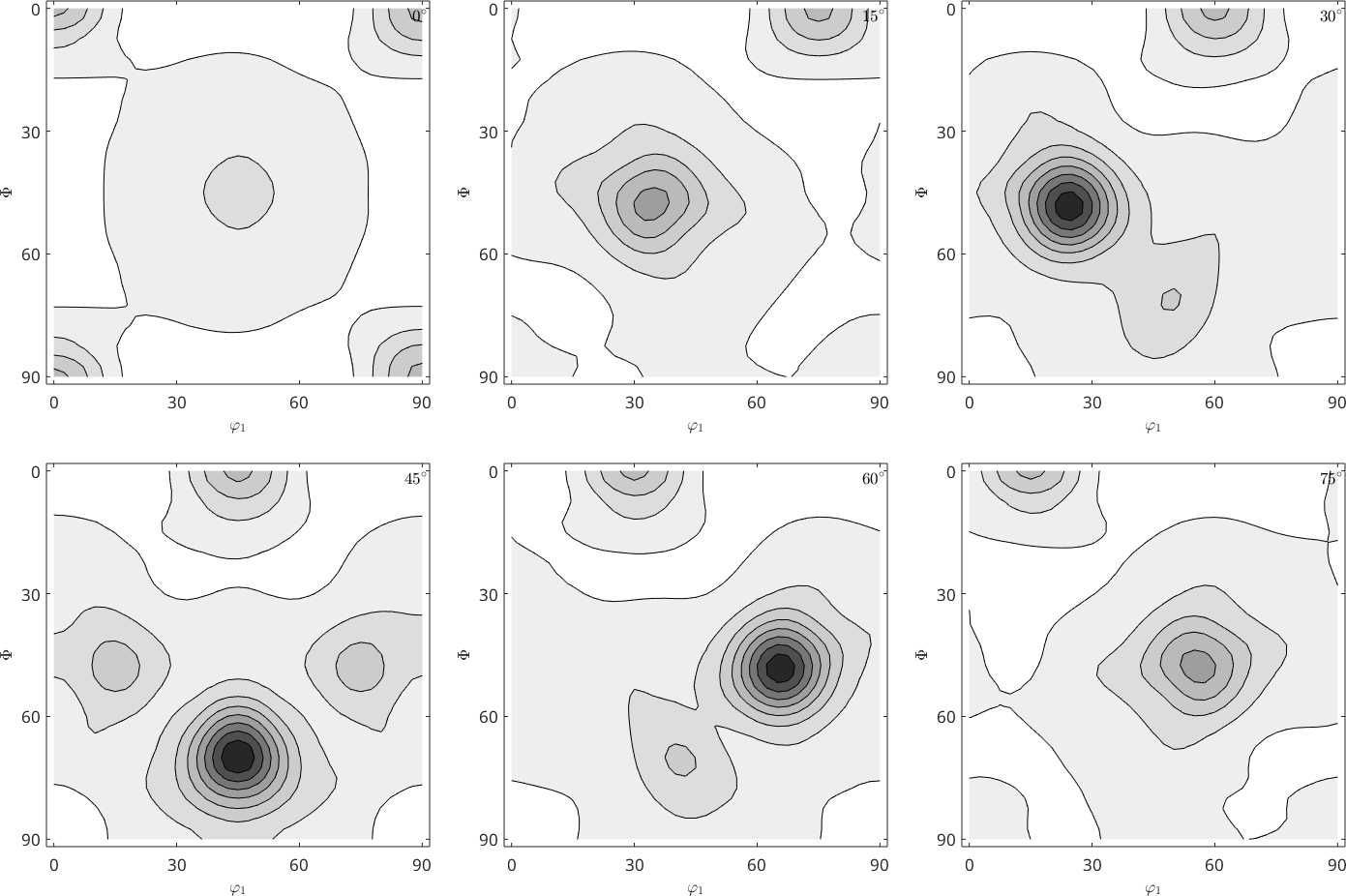
Again we can see the source of the problem in the harmonic coefficients.
close all;
% the harmonic coefficients of the sample ODF
plotSpektra(SantaFe,'bandwidth',32,'linewidth',2,'MarkerSize',10)
% keep plot for adding the next plots
hold on
% the harmonic coefficients of the reconstruction with ghost correction:
plotSpektra(rec,'bandwidth',32,'linewidth',2,'MarkerSize',10)
% the harmonic coefficients of the reconstruction without ghost correction:
plotSpektra(rec2,'bandwidth',32,'linewidth',2,'MarkerSize',10)
legend({'true ODF','with ghost correction','without ghost correction'})
% next plot command overwrites plot
hold off